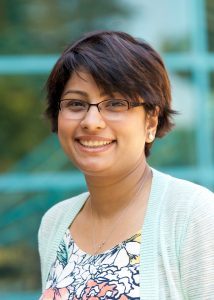Srabanti Chowdhury
Srabanti received her B. Tech in Radiophysics and Electronics from Institute of Radiophysics and Electronics, India and her M.S and PhD in Electrical Engineering from University of California, Santa Barbara.
After finishing her undergraduate studies in India, Srabanti briefly spent a year and a half, exploring the corporate world working in Bangalore, after which she decided to pursue doctoral studies in Electrical engineering. She joined Prof. Umesh Mishra’s group at UC Santa Barbara where she completed her MS (Jun’08) and PhD (Dec’10) in Electrical and Computer Engineering. In her PhD. work, she developed GaN-based vertical devices for power conversion and demonstrated the first vertical GaN power device (CAVET) on single crystalline Gallium Nitride material with then-record (highest) breakdown electric field. After her PhD she joined Transphorm, a California-based company to develop and commercialize GaN based devices for power electronics application. After a couple of fruitful years at Transphorm, she decided to go “back to school’ , this time as a faculty member. She joined the school of Electrical Computer and Energy Engineering at Arizona State University in March’13. She picked up the momentum and continued her work developing solutions for next generation electronics. Her group consists of 8 graduate students and 3 post doctoral researchers. With a dozen of bright minds exploring wide bandgap device technologies, Srabanti continues to build build solutions in her Wide badgap Lab. Besides Gallium Nitride, her research group also focuses on Diamond and Gallium Oxide materials for power and other emerging electronics. In addition to the DARPA Young Faculty Award, she has received the NSF CAREER and AFOSR Young Investigator Program (YIP) in 2015 to continue her research. She has authored and coauthored over 15 journal publications and presented in over 20 conferences. She has over 14 patents (combining issued and filed) on Gallium Nitride and diamond based devices and technologies.
Srabanti received the Young Scientist award at the International Symposium on Compound Semiconductor in 2016
